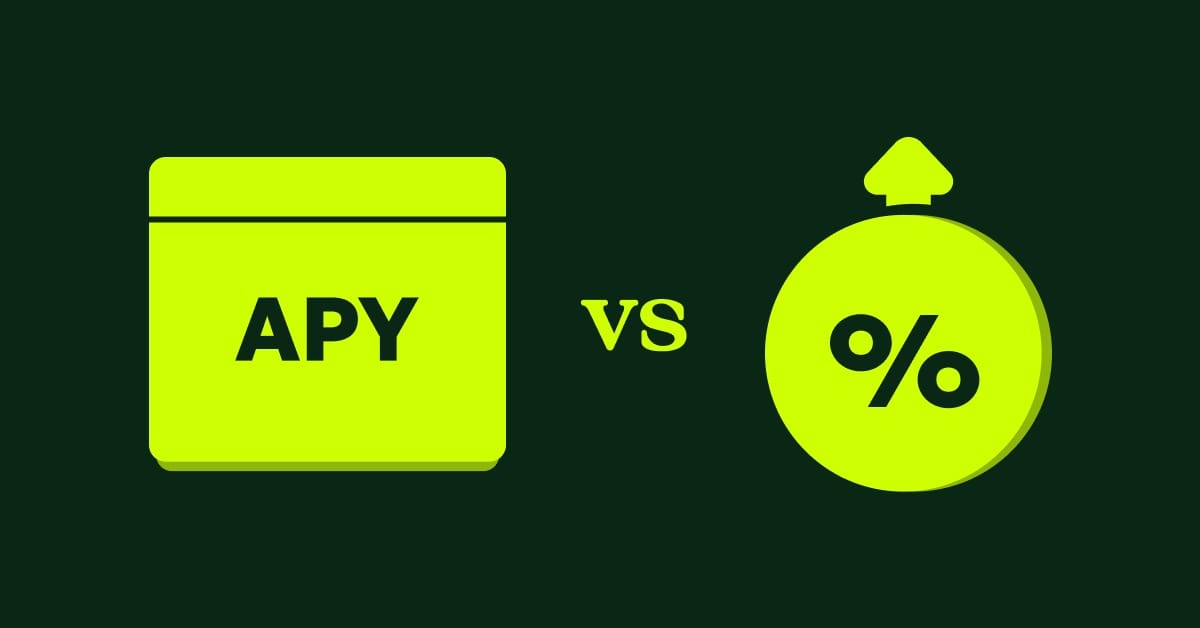APY vs Interest Rate: Unlocking the Secrets to Maximizing Your Savings!

APY vs Interest Rate: What's the Difference?
When you decide to open a savings account, there are a number of factors to consider.
How much money do you need to open the account? Will you be able to access your money easily? And, what is the difference between APY vs interest rate?
What is the difference between APY and interest rate?
The key difference between APY and interest rate is that the APY takes into account the frequency at which interest is calculated and added to the account. In contrast, the interest rate is a simple annual percentage that doesn't take into account the frequency of interest compounding.
In other words, the interest rate is what you'd earn on a deposit if you didn't add any of your interest to the balance and let it compound. The APY, on the other hand, is the actual amount you'll earn on a deposit, taking into account the frequency of compounding.
To illustrate this, let's say you have two savings accounts offering an interest rate of 2% but one compounds daily and the other compounds monthly. The daily compounding account would have a higher APY than the monthly compounding account.
What is APY?
APY, on the other hand, is the total amount of interest you’ll earn on your savings account balance over the course of a year, assuming you don’t make any additional deposits or withdrawals.
APY is a bit more complex than the interest rate, as it takes the impact of compounding into account. Compounding is when you earn interest on your interest, and it’s one of the most powerful wealth-building tools you can use. In fact, the more frequently your account compounds, the more interest you’ll earn.
With that in mind, even if two accounts have the same interest rate, the account with the more frequent compounding will have a higher APY.
What is the formula for APY?
The formula for APY is simple. It multiplies the interest rate by a number that reflects the number of times per year that the interest is compounded. Then it adds 1 and raises the sum to the power of the number of times per year that the interest is compounded.
The formula is:
(1 + r/n)^n - 1
In this formula, r is the interest rate and n is the number of times per year that the interest is compounded.
Here’s an example: Let’s say you invest $1,000 in an account that pays a 5% interest rate compounded annually. In this case, the APY is 5.13%.
What is the interest rate?
The interest rate is the percentage of your principal balance (the amount of money you originally deposited) that the bank pays you in interest.
For example, if you deposit $1,000 in a savings account with a 1% interest rate, you would earn $10 in interest at the end of one year. That’s just the basic formula for calculating interest.
The interest rate is a simple percentage, and it doesn’t take into account the power of compound interest. That’s where the APY comes in.
What is the formula for interest rate?
The formula for interest rate is:
Interest Rate = (Interest Earned / Principal) x 100
To calculate the interest rate, you’ll need to know the amount of interest you’ve earned and the principal amount. The principal amount is the amount you initially deposited in the account.
APY vs Interest Rate: Which One Should I Use?
When it comes to maximizing your savings, always use the APY. The APY takes into account compound interest, which can make a big difference in how much you earn on your money.
Don’t get me wrong, the interest rate is still important. But when you’re comparing savings accounts, CDs, and other interest-bearing accounts, always look at the APY first.
What is the difference between APR and APY?
The annual percentage rate (APR) is used to describe the interest rate for things like loans and credit cards. The APR is the annual rate charged for borrowing money or earned through an investment, and it does not take into account the effect of compounding interest.
The annual percentage yield (APY), on the other hand, is used to describe the interest rate for savings accounts and other interest-earning investment accounts. The APY takes into account the effect of compounding interest and gives you a more accurate sense of how much you can earn on your investment over time.
The Bottom Line
As you can see, the differences between APY and interest rates are subtle, but they can have a big impact on your savings. That’s why it’s important to understand the differences and how they can affect your money.
In general, APY is the best way to compare savings accounts, money market accounts, and CDs. That’s because it takes into account the interest rate and how it’s compounded.
For other types of accounts like checking accounts, credit cards, or loans, the interest rate is the best way to compare. That’s because these accounts don’t have compounding, so there’s no need to use APY.
When you’re comparing financial products, be sure to look at the APY for savings accounts, money market accounts, and CDs. By doing so, you’ll be able to make an apples-to-apples comparison and find the best deal.
Conclusion
The difference between APY and the interest rate is simple. The APY is a more accurate reflection of the interest you will earn in a year. This is because it includes the effects of compounding interest.
The interest rate, on the other hand, is the percentage of the principal that the lender charges you to borrow money. It does not take into account the effects of compounding interest. Therefore, it’s possible for a lender to offer a high-interest rate and a low APY.
Understanding the difference between APY and the interest rate can help you maximize your savings.
